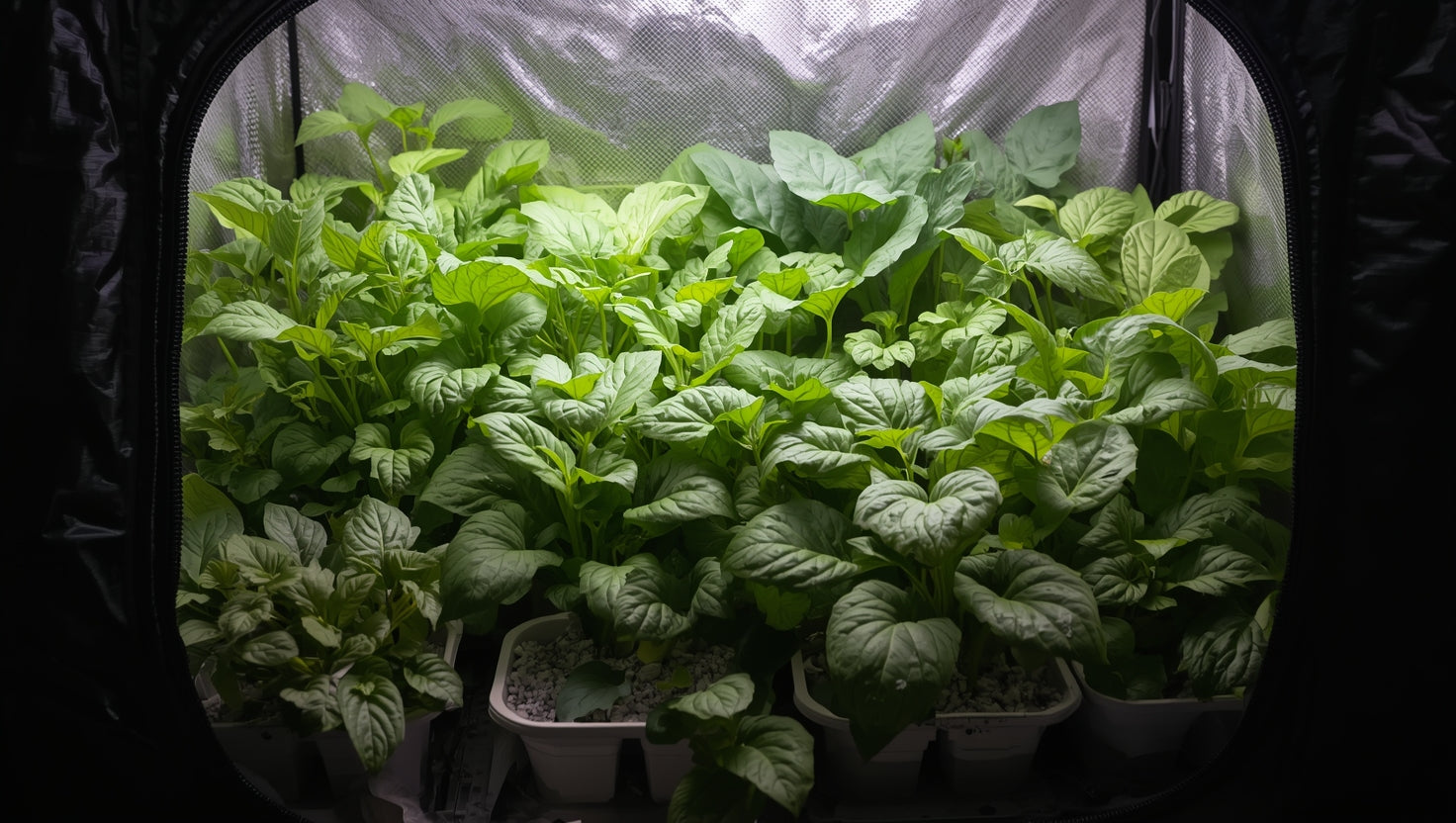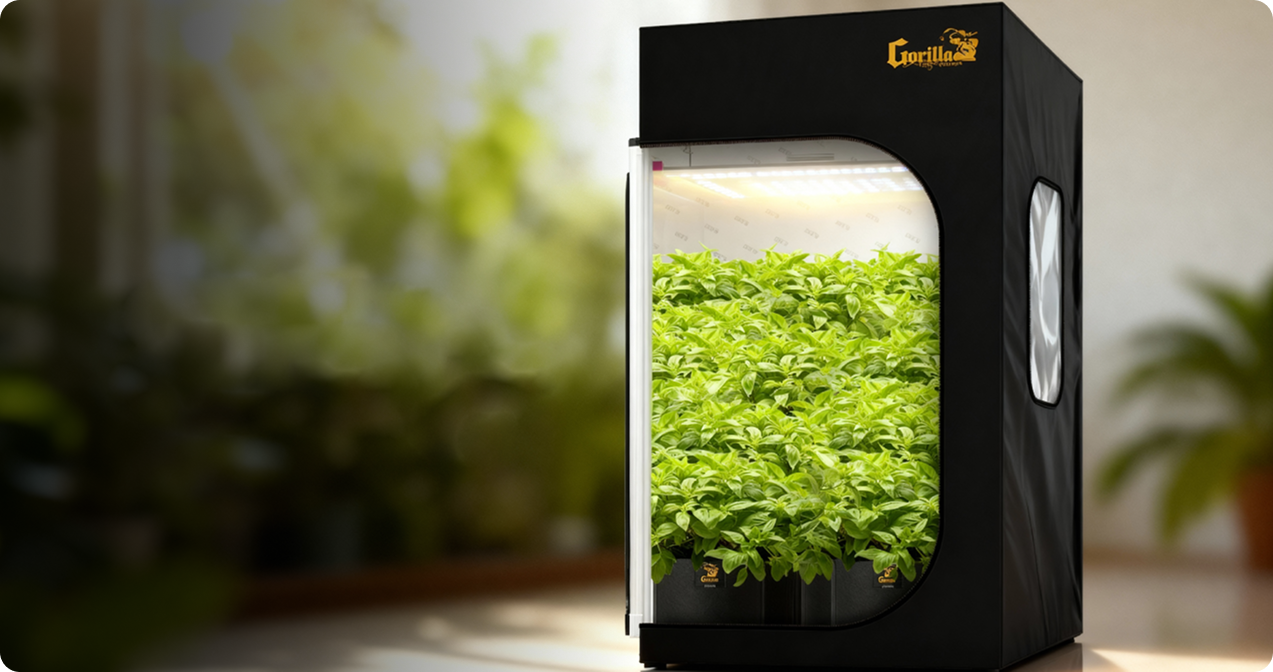
Maximizing Space in Your Indoor Greenhouse: 12 Expert Strategies for Big Yields in Small Spaces (2025 Guide)
Space is often the most limiting factor for indoor growers. Whether you're working with a compact 2'x2' tent or a larger 5'x5' setup, maximizing every cubic inch of your growing environment can dramatically increase your yields and growing options. This comprehensive guide will explore proven strategies to transform your indoor greenhouse into a space-efficient growing powerhouse, no matter how limited your square footage might be.
Why Space Efficiency Matters in Indoor Growing
Before diving into specific techniques, let's understand why space maximization is crucial:
- Higher yields per square foot translate to better return on investment
- Lower operating costs relative to harvest size
- Greater variety of plants possible in limited areas
- More efficient resource usage (light, water, nutrients)
- Better environmental control with proper space planning
With the right approach, even a modest-sized Gorilla Grow Tent can produce harvests that rival much larger growing operations. Let's explore how.
Strategy 1: Go Vertical with Height-Adjustable Grow Tents
The most overlooked dimension in space optimization is height. Traditional growing focuses primarily on floor space, but vertical growing takes full advantage of your tent's height.
Key Implementation Steps:
- Choose a height-adjustable grow tent like the Gorilla Grow Tent Pro which can extend from 7' to 9' with extension kits
- Position taller plants in the center and shorter ones around the perimeter
- Utilize different light heights for plants in different growth stages
As noted on the Gorilla Grow Tent website, "While the majority of grow tents on the market peak at a mere 5 or 6 feet, Gorilla Grow Tent stands head and shoulders above the competition" with their height extension capabilities.

Strategy 2: Implement SCROG (Screen of Green) Techniques
The Screen of Green method uses a horizontal trellis to spread plants laterally instead of vertically, creating an even canopy that maximizes light exposure.
Key Implementation Steps:
- Install a trellis net 8-12 inches above plants when they reach about 12 inches tall
- Gently weave new growth horizontally through the screen as plants develop
- Continue training until you've created a flat, even canopy covering the entire growing area
- Switch to flowering once the screen is about 75% filled
This method can increase yields by 20-40% in the same footprint by ensuring every part of the plant receives optimal light exposure.
Strategy 3: Utilize Multi-Tier Growing Systems
For smaller plants like herbs and leafy greens, multi-tiered setups dramatically increase growing space without expanding your tent's footprint.
Key Implementation Steps:
- Install stackable wire shelving or purpose-built tiered growing racks
- Use low-profile LED lighting for each tier
- Position shorter plants like herbs and microgreens on upper shelves
- Reserve bottom tier for taller plants requiring more vertical clearance
This approach works particularly well when combined with the height-adjustable feature of Gorilla Grow Tents, allowing you to accommodate more growing levels as needed.
Strategy 4: Choose Space-Efficient Container Systems
The right containers can make a significant difference in space utilization:
Space-Optimized Container Options:
- Fabric grow bags rather than rigid pots (more efficient root development in less space)
- Square containers instead of round (up to 25% more containers per square foot)
- Vertical growing towers for small herbs and leafy greens
- Wall-mounted planters attached to tent poles for additional growing surface
For hydroponic growers, the Bubble Flow Buckets Hydroponic Grow System offers an excellent balance of space efficiency and productivity.
Strategy 5: Optimize Plant Selection for Limited Space
Not all plants are created equal when it comes to space efficiency. Strategic plant selection can dramatically increase your yields per square foot.
Space-Efficient Plant Varieties:
- Determinate (bush) tomatoes instead of indeterminate varieties
- Dwarf fruit trees and compact berry varieties
- Cut-and-come-again leafy greens for continuous harvesting
- Compact herb varieties bred specifically for container growing
- Vertical growers like pole beans and cucumbers when properly trellised
For those growing in smaller tents, focus on high-value crops that deliver the most return for limited space investment.
Strategy 6: Master Plant Training Techniques
Strategic training methods allow you to control plant shape and size while maximizing yields:
Effective Training Methods:
- Low-Stress Training (LST) - Gently bending and securing branches to grow horizontally
- Topping and FIMing - Pruning techniques that create multiple main colas instead of one
- Super Cropping - Carefully damaging stems to create stronger, bushier plants
- Lollipopping - Removing lower growth to focus plant energy on upper canopy development
These techniques work particularly well in Gorilla Grow Tents due to their robust frames that provide multiple anchor points for training wires and ties.

Strategy 7: Implement Space-Saving Equipment Mounting
Growing equipment can consume valuable space if not properly managed:
Equipment Space Optimization:
- Mount fans and controllers on tent poles rather than placing on growing surfaces
- Use the Gorilla Grow Tent Gear Board for organized tool and equipment storage
- Install hanging shelves for nutrient bottles and growing supplies
- Choose space-efficient equipment designs like slim-profile LED lights
The GXi ecosystem is particularly helpful here as it "eliminates the mess of wires and controllers that plague other smart systems," creating a cleaner, more space-efficient growing environment.
Strategy 8: Use Air Pruning for Compact, Efficient Root Systems
Air pruning encourages denser, more efficient root systems that require less growing medium:
Implementation Steps:
- Use fabric pots or air pruning containers
- Ensure adequate spacing for air circulation around containers
- Position containers on elevated surfaces with airflow underneath
- Consider mesh bottom trays for maximum air exposure
Healthier, more compact root systems translate to plants that need less space while maintaining productivity.
Strategy 9: Choose the Right Lighting for Your Space
Lighting plays a crucial role in space-efficient growing:
Space-Optimized Lighting Strategies:
- Select Gorilla Xi LED Grow Lights with appropriate coverage for your specific growing area
- For tiered systems, use slim-profile LED bars or panels
- Consider side-lighting for dense canopies to improve light penetration
- Implement light movers in larger tents to cover more area with fewer fixtures
The right lighting configuration ensures every plant receives optimal light without wasting growing space on unnecessary fixtures.
Strategy 10: Implement Vertical Hydroponic Systems
For the ultimate in space efficiency, vertical hydroponic systems provide unmatched yields per square foot:
System Options:
- A-frame vertical hydroponic racks
- Nutrient Film Technique (NFT) wall systems
- Stackable Deep Water Culture (DWC) buckets
- Aeroponic towers
These systems can increase your effective growing surface by 3-5 times compared to traditional horizontal growing.
Strategy 11: Maximize Edge Spaces
Don't overlook the peripheral areas of your growing environment:
Edge Utilization Strategies:
- Hang small containers from tent poles for herbs or microgreens
- Install vertical growing panels on tent walls
- Use hanging baskets from the ceiling for trailing plants
- Position shade-tolerant plants in normally unused corners
Every square inch of your grow tent offers potential growing space when properly utilized.

Strategy 12: Implement Smart Environmental Controls
Space-efficient growing requires precise environmental management:
Space-Saving Environmental Control:
- Use the compact GXi Temperature & Humidity Sensor for precise climate monitoring without taking up valuable space
- Install GXi Inline Fans that automatically adjust based on environmental readings
- Implement wireless monitoring through the Gorilla Grow Tent App to reduce equipment footprint
- Choose multifunctional equipment that combines several features in one unit
As one satisfied customer noted, the GXi Temperature & Humidity Sensor is "Very accurate and it doesn't take up much space at all," making it perfect for space-constrained setups.
Putting It All Together: A Complete Space-Maximized System
For the most effective space utilization, combine multiple strategies in a cohesive system:
Sample Space-Maximized Setup in a 4'x4' Gorilla Grow Tent:
- Use height extension kit to increase vertical growing space
- Install SCROG net for main canopy plants
- Mount space-efficient Xi LED lighting
- Implement tiered side shelving for smaller plants and seedlings
- Use fabric pots with air pruning benefits
- Install GXi environmental controls mounted on tent poles
- Add vertical growing panels on tent walls
- Connect all components to the GXi ecosystem for integrated management
This integrated approach can effectively double or triple your productive growing space compared to conventional methods.
FAQ: Space Maximization in Indoor Greenhouses
Q: How much can I realistically grow in a small 2'x2' tent using these techniques? A: With proper space maximization, a 2'x2' tent can produce 1-2 pounds of leafy greens weekly, 4-6 compact vegetable plants (like peppers or tomatoes), or 8-12 herb plants. Vertical techniques can increase these numbers by 30-50%.
Q: Will these space maximization techniques affect plant health? A: When properly implemented, these methods actually improve plant health through better light exposure, air circulation, and resource distribution. The key is to avoid overcrowding, which can lead to disease and reduced yields.
Q: Do I need to modify my Gorilla Grow Tent for these strategies? A: No modifications are needed. Gorilla Grow Tents are designed with features that support these techniques, including strong frames for hanging equipment, height adjustability, and multiple access ports for environmental management.
Q: How does plant training impact space efficiency? A: Training allows you to control plant architecture to make the most efficient use of space. For example, horizontal training can transform a naturally tall, sparse plant into a shorter, bushier one that produces more yield in the same footprint.
Q: Is it worth investing in automated systems for small spaces? A: Absolutely. The GXi ecosystem can be particularly valuable in small spaces as it optimizes growing conditions with minimal human intervention, ensuring every square inch of your limited space produces maximum results.
Conclusion: Think Beyond the Square Foot
Maximizing space in your indoor greenhouse isn't just about cramming more plants into the same area—it's about intelligent system design that optimizes every dimension of your growing environment. By implementing these strategies with quality equipment like Gorilla Grow Tents and the GXi ecosystem, you can achieve harvests that seem impossible for your limited square footage.
Remember that space efficiency is a journey of continuous improvement. Start with the strategies that make the most sense for your current setup, then progressively implement additional techniques as you gain experience. Soon, you'll be amazed at just how productive your compact growing space can become.
Ready to transform your growing space? Explore our complete selection of Grow Tent Kits designed for maximum space efficiency and productivity.
What space maximization techniques have worked best in your indoor growing environment? Share your experiences in the comments below!

Lena Myles
I'm a mushroom enthusiast and home cook based in Oregon. I'm passionate about foraging and creating fungi-focused recipes, especially delicious, plant-based dishes using gourmet mushrooms like trumpet, shiitake, and oyster. When I’m not in the kitchen, you’ll usually find me wandering the woods in search of new wild flavors.


